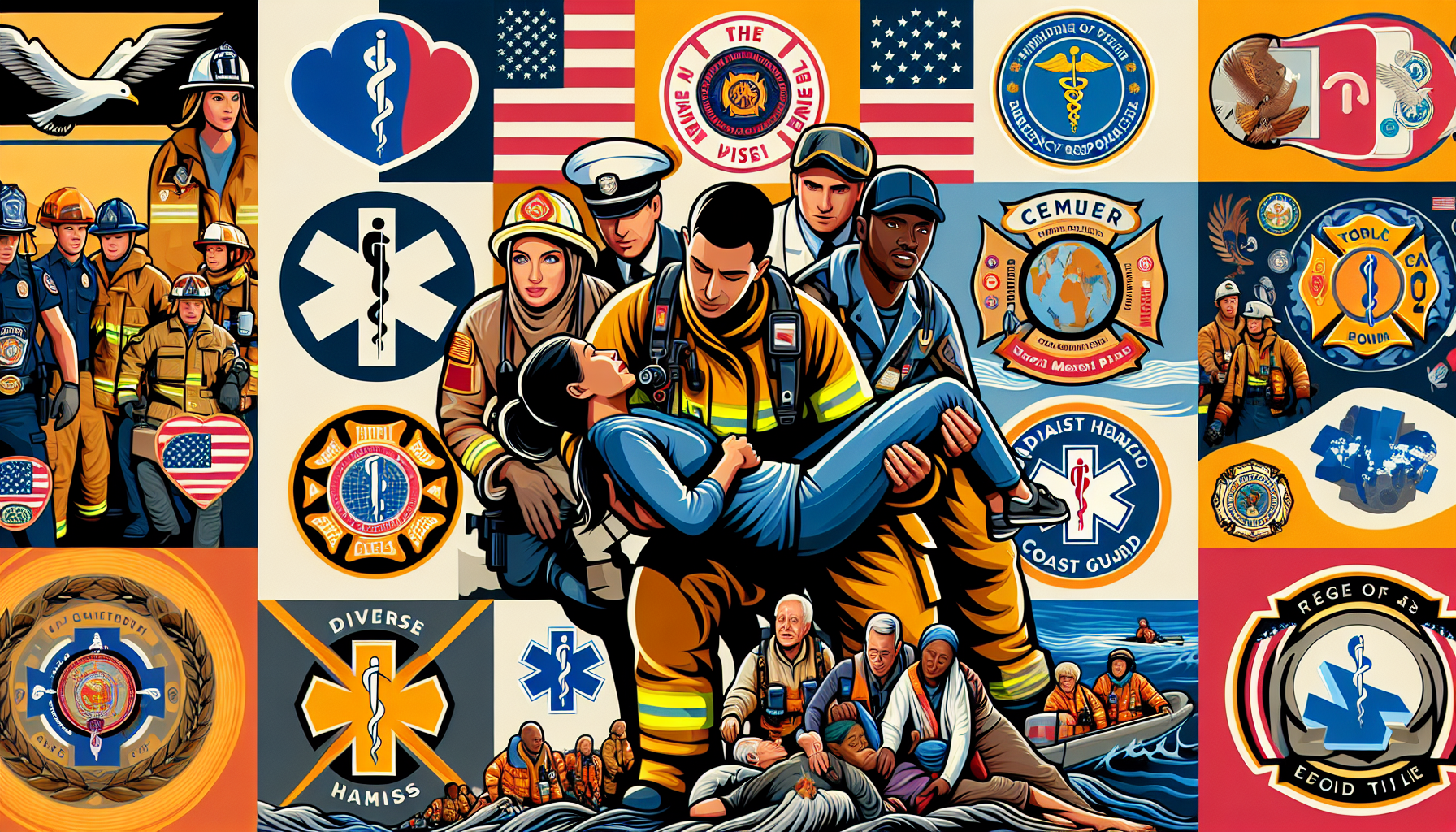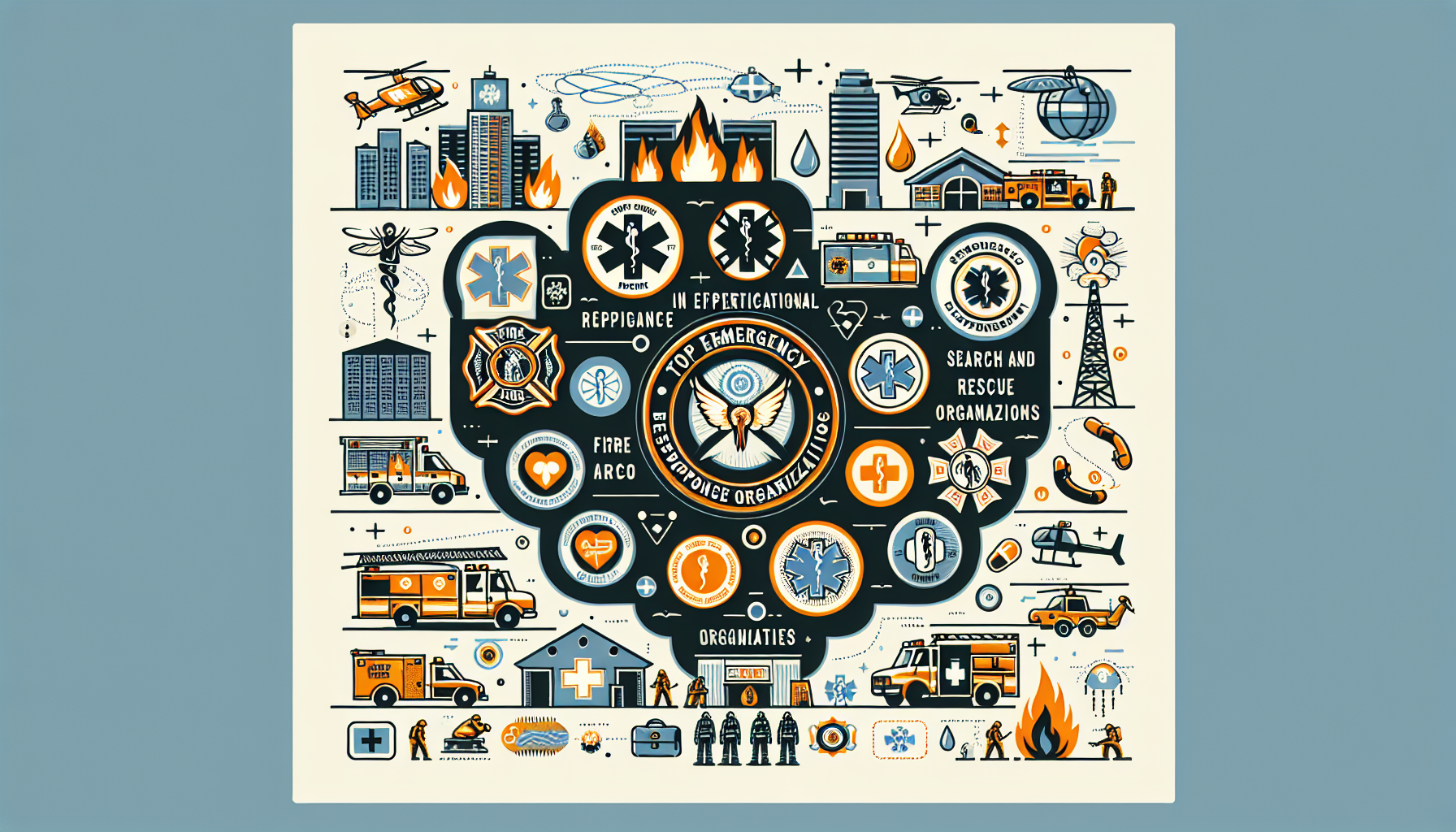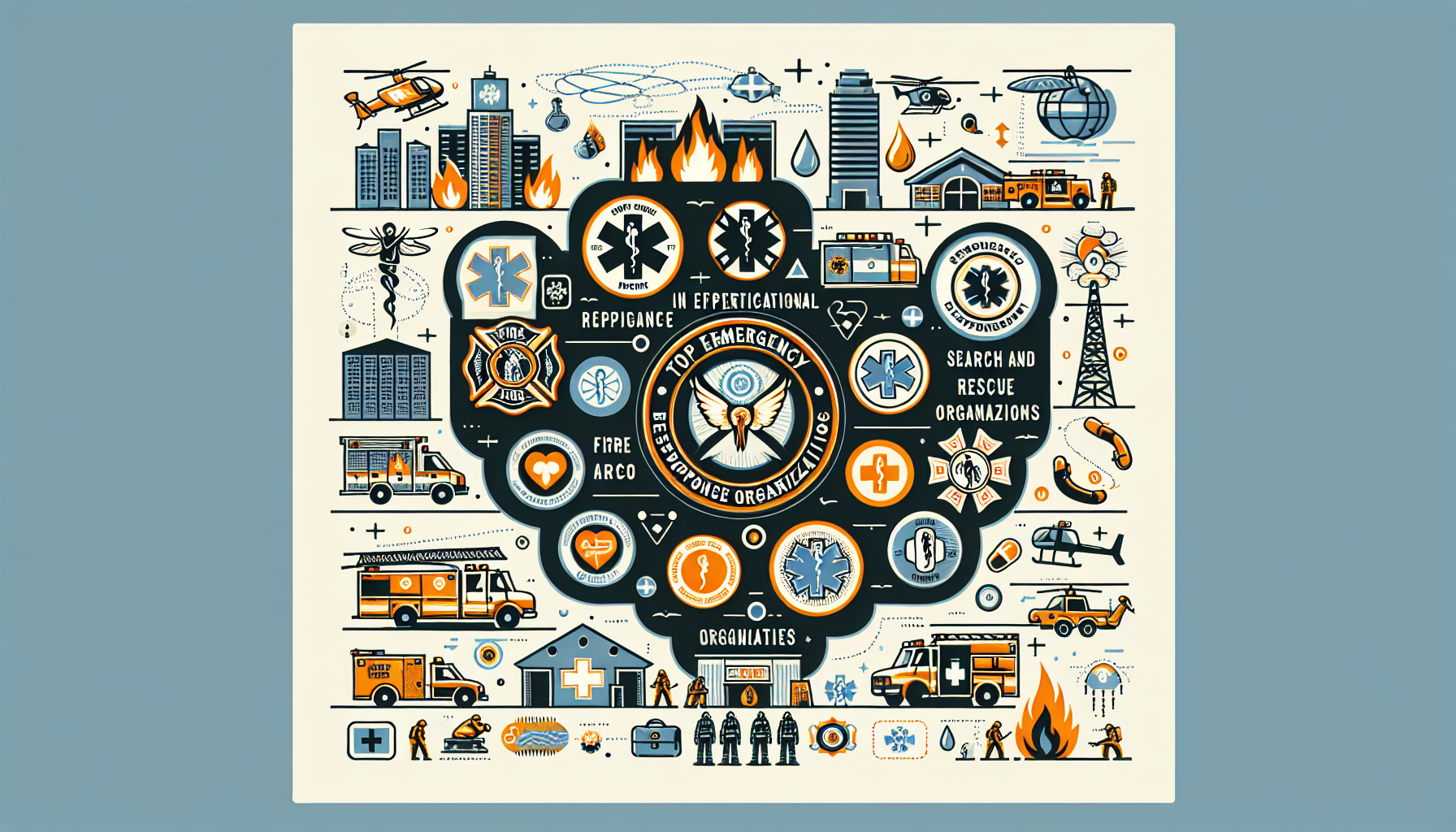In the ever-changing world we live in, being prepared for emergencies is of utmost importance. Whether it’s natural disasters, medical emergencies, or other unforeseen crises, having the right information and support can make all the difference. That’s why we’ve compiled a list of the top emergency response organizations that you should know about. These organizations are dedicated to providing lifesaving assistance and support during times of crisis. From global humanitarian agencies to local community-based groups, they are at the forefront of emergency response efforts, ready to lend a helping hand when it’s needed the most. Discover these essential organizations to ensure you are well-equipped and informed for any emergency situation.

1. American Red Cross
History
The American Red Cross is a renowned humanitarian organization that was founded by Clara Barton in 1881. Its roots can be traced back to the International Red Cross movement and its inspiration from Barton’s experiences as a nurse during the American Civil War. Throughout its history, the American Red Cross has played a crucial role in providing relief and support to those affected by emergencies and disasters in the United States.
Mission
The mission of the American Red Cross is to prevent and alleviate human suffering in the face of emergencies. They provide relief to victims of disasters, support military families, and offer health and safety training and certification. The organization operates under the fundamental principles of humanity, impartiality, neutrality, independence, voluntary service, unity, and universality.
Services
The American Red Cross offers a wide range of services to fulfill its mission. These services include disaster response and recovery, blood donation, health and safety training, support to military families, international services, and humanitarian initiatives. Their disaster response efforts involve providing immediate relief such as shelter, food, and emotional support to those affected by natural disasters like hurricanes, floods, and wildfires.
Volunteer Opportunities
The American Red Cross heavily relies on the support of volunteers to carry out its mission effectively. By volunteering at the American Red Cross, you can make a significant difference in your community and beyond. There are various volunteer opportunities available, such as serving as a disaster response volunteer, blood donor ambassador, health and safety instructor, administrative support volunteer, or a volunteer at local blood drives and health fairs. Volunteering with the American Red Cross allows you to enhance your skills, contribute to a meaningful cause, and make a positive impact on people’s lives.
2. Médecins Sans Frontières (Doctors Without Borders)
History
Médecins Sans Frontières, commonly known as Doctors Without Borders, was established in 1971 by a group of French doctors and journalists. Its founders aimed to create an organization that would provide medical aid and bear witness to the suffering caused by armed conflicts, epidemics, natural disasters, and other emergencies around the world. Since its inception, Médecins Sans Frontières has operated independently and impartially, guided by the principles of humanitarian action.
Mission
The mission of Médecins Sans Frontières is to provide medical assistance to populations in distress, regardless of their race, religion, or political affiliation. The organization is committed to ensuring that all people have access to essential healthcare, particularly those living in contexts where the healthcare system is inadequate or disrupted. Médecins Sans Frontières also emphasizes the importance of speaking out about the suffering and needs of the people they serve.
Areas of Operation
Médecins Sans Frontières operates in numerous countries worldwide, responding to emergencies and providing medical care where it is most needed. Their areas of operation include regions affected by armed conflicts, outbreaks of diseases such as Ebola and COVID-19, natural disasters, and other complex humanitarian crises. The organization deploys experienced medical professionals, logisticians, and support staff to deliver healthcare, conduct vaccination campaigns, and address the specific needs of the affected communities.
Medical and Humanitarian Work
Médecins Sans Frontières conducts a wide range of medical and humanitarian activities to fulfill its mission. They provide primary healthcare services, surgical interventions, comprehensive treatment for diseases like malaria and HIV/AIDS, mental health support, and nutrition programs. Additionally, they strive to improve access to clean water and sanitation facilities, conduct emergency vaccinations, and offer training and support to local healthcare providers. Through their work, Médecins Sans Frontières brings lifesaving medical care to vulnerable populations in some of the most challenging environments across the globe.
3. International Rescue Committee
History
The International Rescue Committee (IRC) was founded in 1933 at the request of Albert Einstein. The organization was established to provide emergency relief and resettlement assistance to refugees fleeing Nazi-controlled Europe. Over the years, the IRC has expanded its focus to support individuals and communities affected by conflict and disaster around the world.
Mission
The mission of the IRC is to help people whose lives and livelihoods are shattered by conflict and disaster to survive, recover, and regain control of their futures. The organization is guided by humanitarian principles and strives to ensure that the rights and dignity of every individual are respected, protected, and fulfilled.
Areas of Expertise
The IRC has developed expertise in various areas critical to addressing the needs of people affected by crises. These areas include health, education, economic wellbeing, safety, and power to change. The organization recognizes that individuals and communities require multifaceted support to rebuild their lives and become self-sufficient. By focusing on these areas, the IRC aims to empower those affected by emergencies to overcome their challenges and secure a better future.
Programs and Services
The IRC implements a wide range of programs and services designed to provide assistance and support to vulnerable populations. These programs include emergency response, healthcare services, education initiatives, economic recovery and development, protection of human rights, and assistance to displaced persons and refugees. Through their programs, the IRC works collaboratively with local communities and partners to ensure impactful and sustainable solutions to the complex challenges faced by individuals affected by crises.
4. World Food Programme
History
The World Food Programme (WFP) is the leading humanitarian organization dedicated to addressing hunger and promoting food security worldwide. It was established in 1961 as an initiative of the United Nations to provide food assistance to those in need. Over the years, the WFP has played a vital role in responding to emergencies, supporting development projects, and shaping policies to combat hunger.
Mission
The mission of the World Food Programme is to end hunger, promote food security, and improve nutrition for the most vulnerable populations, particularly in crisis-affected areas. The organization works towards achieving this mission by providing food assistance, implementing nutrition programs, supporting sustainable agriculture, and advocating for policies that address the root causes of hunger and malnutrition.
Areas of Focus
The WFP focuses its efforts on several key areas to accomplish its mission effectively. These areas include emergency response, school feeding programs, nutrition initiatives, livelihood and resilience-building projects, and assistance to refugees and internally displaced persons. By addressing these areas, the organization aims to alleviate hunger and malnutrition, increase access to nutritious food, and promote self-sufficiency and resilience among vulnerable communities.
Food Assistance Initiatives
The World Food Programme delivers food assistance through a variety of programs and interventions tailored to the unique needs of specific contexts. They provide in-kind food assistance, cash-based transfers, and vouchers to ensure that people have access to nutritious food. The WFP also prioritizes programs that empower women, support local agricultural production, build community resilience, and integrate nutrition-sensitive approaches to address malnutrition comprehensively.

5. Federal Emergency Management Agency (FEMA)
History
The Federal Emergency Management Agency (FEMA) is an agency of the United States Department of Homeland Security. It was established in 1979 to coordinate and respond to emergencies and disasters within the United States and to support local and state governments in their disaster response and recovery efforts.
Mission
The mission of FEMA is to help people and communities prepare for, respond to, recover from, and mitigate the impacts of disasters. The agency’s primary goal is to ensure that the United States is prepared to handle all hazards, whether natural, technological, or man-made, and to minimize the loss of life, property, and impact on the economy.
Responsibilities
FEMA has a wide range of responsibilities related to emergency management and disaster response. These include coordinating and supporting emergency response efforts, providing financial assistance to individuals and communities affected by disasters, conducting preparedness and mitigation activities, and promoting resilience and recovery. FEMA also collaborates with various federal, state, local, tribal, and non-profit partners to ensure a comprehensive and coordinated approach to emergency management in the United States.
Disaster Response and Recovery
FEMA plays a crucial role in coordinating disaster response and recovery efforts. The agency deploys personnel, resources, and technical expertise to support affected communities during and after disasters. This includes providing emergency shelter, food, and water; conducting damage assessments; coordinating search and rescue operations; facilitating the distribution of essential supplies; and assisting with the restoration of critical infrastructure. FEMA’s focus is on ensuring the safety and well-being of individuals and communities while helping them rebuild and recover in the aftermath of disasters.
6. United Nations Office for the Coordination of Humanitarian Affairs (OCHA)
History
The United Nations Office for the Coordination of Humanitarian Affairs (OCHA) was established in 1991 to strengthen the international response to humanitarian emergencies and improve coordination among humanitarian actors. OCHA serves as the primary coordination body within the United Nations system for humanitarian action and disaster response.
Mission
The mission of OCHA is to mobilize and coordinate humanitarian assistance to save lives, protect the rights and well-being of affected people, and ensure a principled and effective response to emergencies. OCHA works to ensure timely and effective coordination of humanitarian actions, enhance preparedness and response capacity, advocate for the rights and needs of affected populations, and promote humanitarian principles and standards.
Coordination Role
OCHA plays a vital coordination role in humanitarian crises by bringing together governments, United Nations agencies, non-governmental organizations, and other partners to ensure a coherent and collaborative response. The organization facilitates information sharing, resource mobilization, strategic planning, and advocacy to address the immediate and long-term needs of affected populations. OCHA also supports the development and implementation of humanitarian policies, guidelines, and standards to improve the overall effectiveness and efficiency of humanitarian action.
Global Humanitarian Response
OCHA’s mandate extends beyond any specific geographical area, enabling the organization to respond to emergencies and support coordination efforts worldwide. OCHA works in close collaboration with humanitarian actors on the ground to assess needs, coordinate response activities, and prioritize assistance based on the severity and urgency of the situation. By promoting coordination and cooperation, OCHA helps ensure that humanitarian assistance reaches those most in need in a timely and effective manner.
7. Team Rubicon
History
Team Rubicon is a disaster response organization that was founded after the 2010 earthquake in Haiti. It was initially established as a veterans’ service organization, with the aim of uniting the skills and experiences of military veterans to provide rapid and effective disaster response and recovery assistance.
Mission
The mission of Team Rubicon is to provide disaster response services by leveraging the skills and experiences of military veterans and first responders. The organization aims to bridge the gap between the immediate aftermath of a disaster and the arrival of long-term recovery assistance, offering immediate relief to affected communities and helping them on the path to recovery.
Disaster Response Operations
Team Rubicon deploys teams of skilled volunteers to disaster-affected areas around the world. These teams, known as “Greyshirts,” provide a variety of services, including debris removal, damage assessments, muck-outs, and community support. Team Rubicon’s unique approach combines the expertise of veterans, first responders, and medical professionals to provide efficient and effective disaster response operations.
Veteran and Civilian Volunteer Opportunities
Team Rubicon offers both veteran and civilian volunteer opportunities for individuals looking to make a difference in disaster-affected communities. Veterans and first responders can utilize their skills and experiences gained during their service to contribute to disaster response efforts. Civilian volunteers can also join Team Rubicon and receive training to become skilled responders in disaster-affected areas. By volunteering with Team Rubicon, individuals have the opportunity to serve others, build communities, and find a renewed sense of purpose.
8. Save the Children
History
Save the Children is a global humanitarian organization that was founded in 1919. It was established in response to the impact of World War I on children and has since grown to become one of the world’s leading advocates and providers of support for children in need.
Mission
The mission of Save the Children is to improve the lives of children around the world, particularly those facing poverty, violence, and discrimination. The organization works to ensure that every child has the opportunity to grow up healthy, educated, and safe. Save the Children’s approach is child-centered, emphasizing the importance of addressing children’s unique needs and perspectives in all aspects of their work.
Areas of Focus
Save the Children focuses its efforts on several key areas to achieve its mission effectively. These areas include health and nutrition, education, child protection, livelihoods, and emergencies. By addressing these fundamental aspects of children’s well-being, Save the Children aims to create lasting change and improve the lives of children in even the most challenging circumstances.
Child Protection and Emergency Response
Save the Children is dedicated to protecting children from harm and providing immediate assistance in times of crisis. The organization works to prevent and respond to various forms of abuse, exploitation, and violence that children may face, such as child labor, trafficking, and recruitment into armed forces. Save the Children also strives to ensure that children’s needs are met during emergencies, providing essential services such as food, shelter, healthcare, and psychological support to affected children and their families.
9. Rapid Response Mechanism
Background
The Rapid Response Mechanism (RRM) is an innovative approach to delivering humanitarian aid quickly and efficiently to people affected by emergencies. It was developed in response to the challenges of delivering timely assistance in complex and rapidly changing humanitarian contexts.
Mission
The mission of the Rapid Response Mechanism is to provide rapid and coordinated humanitarian aid to populations affected by emergencies, with a focus on meeting their most urgent needs. The RRM aims to bridge the gap between the onset of a crisis and the deployment of traditional humanitarian assistance, ensuring that affected communities receive crucial support in a timely manner.
Coordination and Implementation
The Rapid Response Mechanism relies on close coordination among humanitarian organizations, government agencies, local communities, and other key stakeholders. By pooling resources, expertise, and capacities, the RRM enables a more effective and efficient response to emergencies. Through coordinated assessments, joint planning, and streamlined decision-making processes, the RRM ensures that resources are allocated based on the most critical needs and priorities on the ground.
Rapid Humanitarian Aid
The Rapid Response Mechanism focuses on providing immediate and life-saving assistance to affected populations. This assistance may include the provision of emergency food and non-food items, temporary shelter, clean water and sanitation facilities, healthcare services, and protection support. The RRM strives to deliver aid within a short timeframe, allowing affected communities to recover and regain their resilience more rapidly.
10. The Salvation Army
History
The Salvation Army is a global Christian organization that was founded in London in 1865. Its mission is rooted in Christian faith and a commitment to serving those in need. The organization operates in over 130 countries and provides a wide range of social services and emergency response efforts.
Mission
The mission of The Salvation Army is to meet human needs without discrimination, ensuring that basic needs are met and that individuals have the opportunity for personal growth and spiritual development. The organization aims to alleviate suffering, provide practical support, and help individuals and communities overcome challenges and improve their quality of life.
Community Support Programs
The Salvation Army offers various community support programs to address the needs of vulnerable populations. These programs include food pantries, homeless shelters, addiction recovery services, job training and employment assistance, youth programs, and senior care services. The organization focuses on providing a holistic approach to support, addressing not only immediate needs but also offering resources and opportunities for long-term stability and well-being.
Disaster Relief Efforts
The Salvation Army has a long history of providing disaster relief and emergency response services. When disasters strike, the organization swiftly mobilizes resources and personnel to provide immediate assistance to affected communities. This assistance may include providing food and hydration, emergency shelter, emotional and spiritual care, financial aid, and long-term recovery support. The Salvation Army’s extensive network and infrastructure enable them to respond effectively to emergencies and provide relief to those in need.
In conclusion, these top emergency response organizations play a critical role in providing humanitarian assistance, responding to emergencies, and meeting the needs of vulnerable populations around the world. From their historic roots to their current missions, these organizations exemplify dedication, compassion, and a commitment to making a positive impact on people’s lives. Whether it’s providing immediate relief in the aftermath of a disaster, delivering lifesaving medical care, ensuring access to food and nutrition, or advocating for the rights and well-being of those affected by emergencies, these organizations deserve recognition and support. By working together and engaging with these organizations, individuals can contribute to a safer, more resilient world for all.
